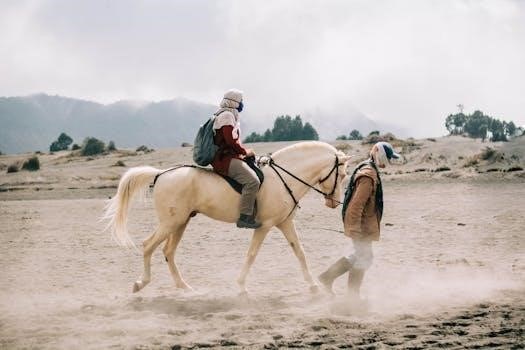
nature guide
Nature Guide⁚ A Comprehensive Overview
A nature guide is a professional who leads individuals or groups, revealing the hidden treasures of natural landscapes. They provide unforgettable experiences by sharing knowledge about flora, fauna, and ecological processes, fostering appreciation and understanding of the environment.
Defining a Nature Guide
Defining a nature guide goes beyond simply leading tours; it encompasses a multifaceted role that blends education, interpretation, and conservation. A nature guide is a knowledgeable professional who facilitates exploration and understanding of the natural world. Unlike a general tour guide, their focus lies specifically on natural environments, such as national parks, reserves, and botanical gardens.
They possess a deep understanding of local ecosystems, including flora, fauna, geology, and natural processes. Their primary function is to interpret these elements for visitors, fostering appreciation and awareness. Beyond identification, they weave narratives that connect the environment to broader ecological principles, cultural history, and conservation efforts.
A nature guide is also an educator, providing information in an engaging and accessible manner. They tailor their approach to different audiences, ensuring that everyone can connect with the natural world. Furthermore, ethical nature guiding emphasizes responsible tourism practices. Guides promote conservation by educating visitors on minimizing their impact and supporting sustainable initiatives.
In essence, a nature guide is a conduit between people and nature, fostering respect, understanding, and a sense of stewardship for the environment.
The Aim of Nature Guiding
The aim of nature guiding extends far beyond merely pointing out interesting plants or animals. The core aim of nature guiding is to foster a deeper understanding and appreciation of the natural world among participants. It seeks to connect individuals with nature on a personal level, instilling a sense of wonder and respect for the environment.
Nature guiding aims to educate participants about ecological processes, biodiversity, and the interconnectedness of all living things. By sharing knowledge about local flora, fauna, geology, and cultural history, guides help visitors understand the complexities of the ecosystem they are exploring.
A key objective is to promote responsible tourism and conservation ethics. Nature guides educate visitors on minimizing their impact on the environment and encourage them to adopt sustainable practices in their daily lives. They highlight the importance of protecting natural resources for future generations.
Furthermore, nature guiding strives to provide enriching and memorable experiences. By engaging multiple senses and encouraging active participation, guides create opportunities for visitors to connect with nature in meaningful ways. Ultimately, the aim is to inspire a lifelong commitment to environmental stewardship.
Nature guides want to leave the world a better place!
Principles of Ethical Nature Guiding
Ethical nature guiding hinges on minimizing environmental impact. Guides must prioritize conservation, adhering to Leave No Trace principles by avoiding disturbance to flora, fauna, and geological features. Responsible waste management, noise reduction, and staying on marked trails are crucial.
Respect for wildlife is paramount. Guides maintain a safe distance from animals, avoiding any actions that could cause stress or alter their natural behavior. Feeding wildlife is strictly prohibited, as it disrupts ecosystems and creates dependency.
Accurate and truthful interpretation is essential. Guides present information based on scientific evidence and local knowledge, avoiding speculation or misinformation. Cultural sensitivity is vital, respecting local traditions and engaging with communities responsibly.
Safety is a top priority. Guides are trained in first aid, risk assessment, and emergency procedures. They ensure participants are adequately prepared for the conditions and activities, providing clear instructions and monitoring their well-being.
Continuous learning and professional development are integral to ethical guiding. Guides stay updated on environmental issues, conservation efforts, and best practices in interpretation. They act as ambassadors for nature, promoting respect, understanding, and responsible stewardship among visitors, thereby shaping a better world!
Essential Skills for a Nature Guide
A successful nature guide requires a diverse skill set, blending knowledge, communication, and practical abilities. Strong interpretive skills are fundamental, enabling guides to translate complex natural processes into engaging narratives that resonate with diverse audiences;

In-depth knowledge of local flora, fauna, geology, and ecology is crucial. Guides must accurately identify species, understand their interactions, and explain the dynamics of the ecosystem. This includes awareness of conservation issues and local environmental challenges.
Effective communication skills are paramount. Guides must articulate information clearly, adapt their style to different learning preferences, and foster engaging discussions. They should be adept at storytelling, using metaphors and anecdotes to create memorable experiences.
Navigation and orientation skills are essential for leading groups safely in the outdoors. Guides must be proficient in map reading, compass use, and GPS technology. They should be able to assess terrain, identify potential hazards, and navigate in various weather conditions.
First aid and emergency response training are indispensable. Guides must be prepared to handle medical emergencies, administer first aid, and coordinate evacuations if necessary. Strong leadership skills, problem-solving abilities, and a calm demeanor are vital in crisis situations, ensuring the safety and well-being of participants.
Types of Nature Tours
Nature tours encompass a wide array of experiences, catering to diverse interests and physical abilities. Birdwatching tours focus on identifying and observing avian species, often led by experts with extensive knowledge of bird calls and habitats. These tours may involve early morning excursions and specialized equipment like binoculars and spotting scopes.
Hiking and trekking tours explore natural landscapes on foot, ranging from leisurely walks to challenging multi-day expeditions. These tours emphasize physical activity and immersion in the environment, offering opportunities to observe flora, fauna, and geological features up close.
Wildlife safaris provide opportunities to observe animals in their natural habitats. These tours often involve transportation in specialized vehicles, guided by experienced trackers and naturalists. Safaris may focus on specific species or ecosystems, such as African savanna safaris or Amazon rainforest expeditions.
Botanical tours delve into the world of plants, exploring diverse ecosystems from wildflower meadows to tropical rainforests. These tours highlight plant identification, ecological relationships, and the medicinal or cultural uses of plants.
Ecotours prioritize sustainability and environmental responsibility, minimizing impact on the environment and supporting local communities. These tours often incorporate educational components, promoting conservation awareness and responsible travel practices, fostering harmony between humans and the environment.
Field Guides⁚ Tools of the Trade
Field guides are indispensable resources for nature guides, serving as portable libraries of information about flora, fauna, and other natural elements. These guides are designed for use in the field, providing concise descriptions, illustrations, and identification keys to help users distinguish between similar species or objects.
A well-stocked nature guide’s toolkit includes a variety of field guides covering different aspects of the natural world. Botanical guides aid in identifying plants, providing information on leaf shape, flower structure, and habitat preferences. Wildlife guides focus on animals, offering descriptions of physical characteristics, behavior, and distribution.
Geological guides assist in identifying rocks, minerals, and landforms, explaining their formation and significance. Regional guides provide comprehensive coverage of the natural history of a specific area, encompassing plants, animals, geology, and ecology.
Effective use of field guides requires familiarity with their organization and terminology. Nature guides must be able to quickly locate relevant information, interpret illustrations, and apply identification keys accurately. They also need to be aware of the limitations of field guides, recognizing that identification can sometimes be challenging or require expert consultation.
Beyond traditional printed guides, digital field guides are increasingly available, offering features such as interactive maps, audio recordings, and image recognition software, enhancing the learning experience.
Identifying Flora and Fauna
A core skill for any nature guide is the ability to accurately identify local flora and fauna. This expertise allows them to enrich the tour experience, providing fascinating details about the plants and animals encountered. Identification involves a combination of observation, knowledge of key characteristics, and the use of field guides and other resources.
For plants, nature guides learn to recognize different species by examining leaf shape, flower structure, bark patterns, and overall growth habit. They also consider habitat preferences and seasonal changes. Similarly, animal identification relies on observing physical features, such as size, color, markings, and behavior. Tracks, calls, and other signs can also provide clues.
Field guides are essential tools, offering descriptions and illustrations to aid identification. However, nature guides develop their own observational skills, learning to notice subtle differences that distinguish similar species. They also stay updated on the latest taxonomic information, as scientific classifications can change.
Moreover, ethical considerations are crucial. Nature guides emphasize non-intrusive observation, avoiding disturbance to wildlife or damage to plants. They also educate visitors about responsible behavior, promoting conservation and respect for the natural world. By sharing their knowledge and enthusiasm, nature guides inspire a deeper connection with nature.
Understanding Natural Selection
A knowledgeable nature guide possesses a solid understanding of natural selection, the driving force behind evolution and adaptation. This knowledge allows them to explain the intricate relationships between organisms and their environment, revealing how species have evolved over time to thrive in specific niches. Natural selection, in essence, is the process where organisms with traits better suited to their environment tend to survive and reproduce at higher rates than others.
Nature guides can illustrate this concept by pointing out examples of adaptation in the field. For instance, they might explain how the camouflage of certain insects helps them avoid predators, or how the long beaks of some birds enable them to access nectar deep within flowers. They can also discuss the impact of environmental changes on natural selection, highlighting how species must adapt or face extinction.
Furthermore, a nature guide understands the different types of natural selection⁚ stabilizing, directional, and disruptive. Stabilizing selection favors average traits, directional selection favors traits at one extreme, and disruptive selection favors traits at both extremes. These processes shape populations and maintain genetic diversity.

By explaining natural selection, nature guides help visitors appreciate the dynamic nature of ecosystems and the interconnectedness of all living things. This understanding fosters a deeper respect for biodiversity and the importance of conservation efforts.
The Role of Nature Guides in Conservation
Nature guides play a crucial role in conservation by fostering environmental awareness and promoting responsible behavior among visitors. They act as interpreters, connecting people with nature and instilling a sense of stewardship for the environment. By sharing their knowledge of local ecosystems, they help visitors understand the importance of biodiversity and the threats it faces.
One of the key ways nature guides contribute to conservation is through education. They explain the ecological significance of different habitats, highlighting the delicate balance of nature and the impact of human activities. They can also provide practical tips on how visitors can minimize their environmental footprint, such as staying on marked trails, avoiding disturbing wildlife, and properly disposing of waste.
Furthermore, nature guides can advocate for conservation by supporting local initiatives and promoting sustainable tourism practices. They can work with local communities to protect natural resources and ensure that tourism benefits local economies. By sharing success stories and highlighting conservation challenges, they inspire visitors to become advocates for environmental protection in their own communities.
Nature guides can also contribute to scientific research by collecting data on wildlife populations, monitoring environmental conditions, and reporting any signs of habitat degradation. This information can be used to inform conservation efforts and guide management decisions. Ultimately, nature guides serve as ambassadors for conservation, helping to create a more sustainable future for all.
Nature’s Metaphors⁚ Finding Meaning in the Wild
Nature offers a rich tapestry of metaphors that can illuminate our understanding of life, ourselves, and the world around us. By observing the natural world, we can gain insights into complex concepts such as growth, change, resilience, and interconnectedness. Nature guides can facilitate this process by helping visitors to see beyond the surface and discover the deeper meanings embedded in the wild.
For example, rivers are often seen as metaphors for life’s journey. The source of a river, a small mountain stream, represents the beginnings of life, while its meeting with the ocean symbolizes the end. The river’s winding path, with its rapids and calm stretches, reflects the challenges and triumphs we encounter along the way. Similarly, forests can be viewed as metaphors for communities, with individual trees representing individuals and the forest as a whole representing the collective.

Nature guides can encourage visitors to reflect on these metaphors and apply them to their own lives. They can ask questions such as, “What does this landscape remind you of?” or “How does this animal’s behavior relate to human behavior?” By prompting contemplation and discussion, nature guides can help visitors connect with nature on a deeper level and find personal meaning in their experiences.

Furthermore, nature guides can share stories and legends that incorporate natural metaphors, enriching the experience and fostering a sense of wonder. By exploring nature’s metaphors, we can gain a new perspective on life and our place within it.